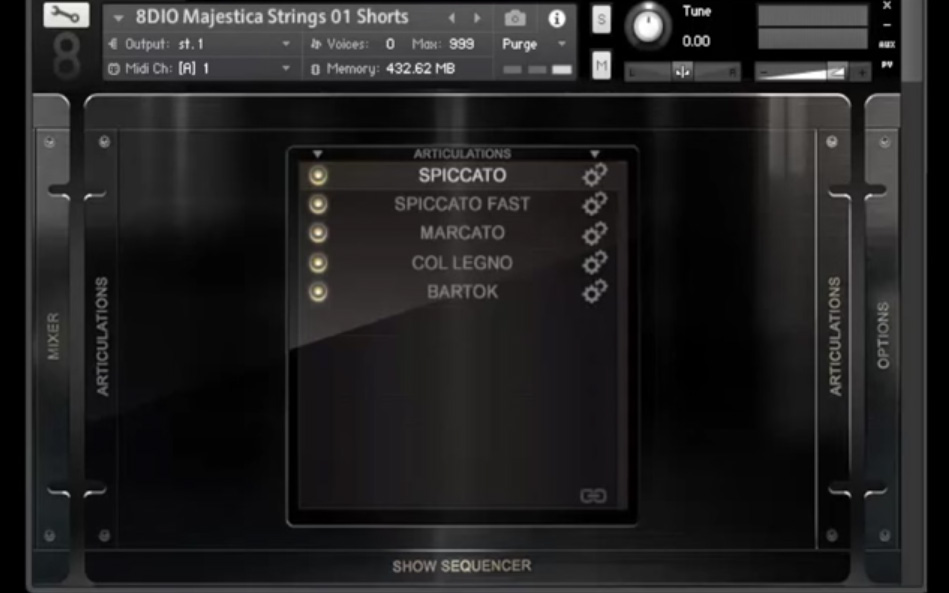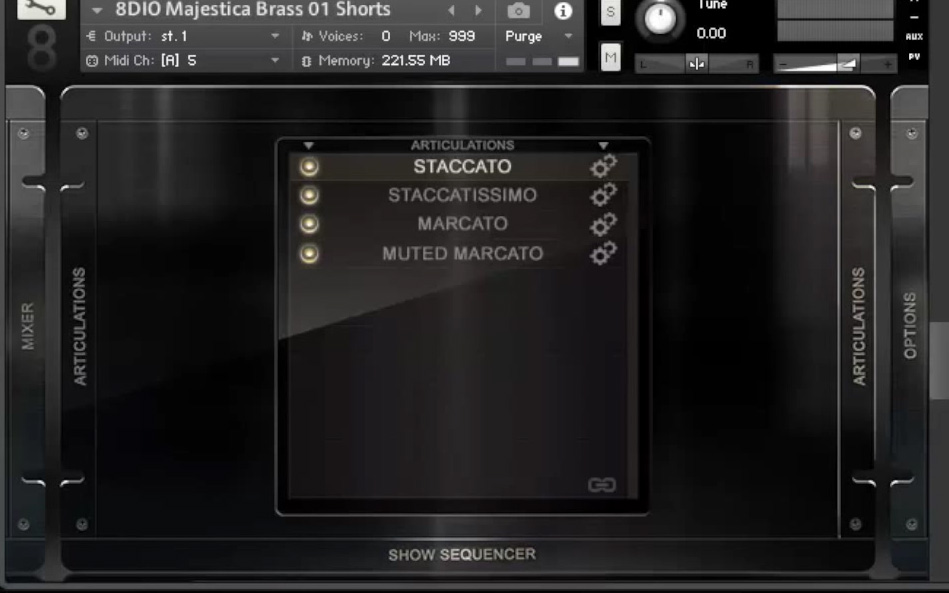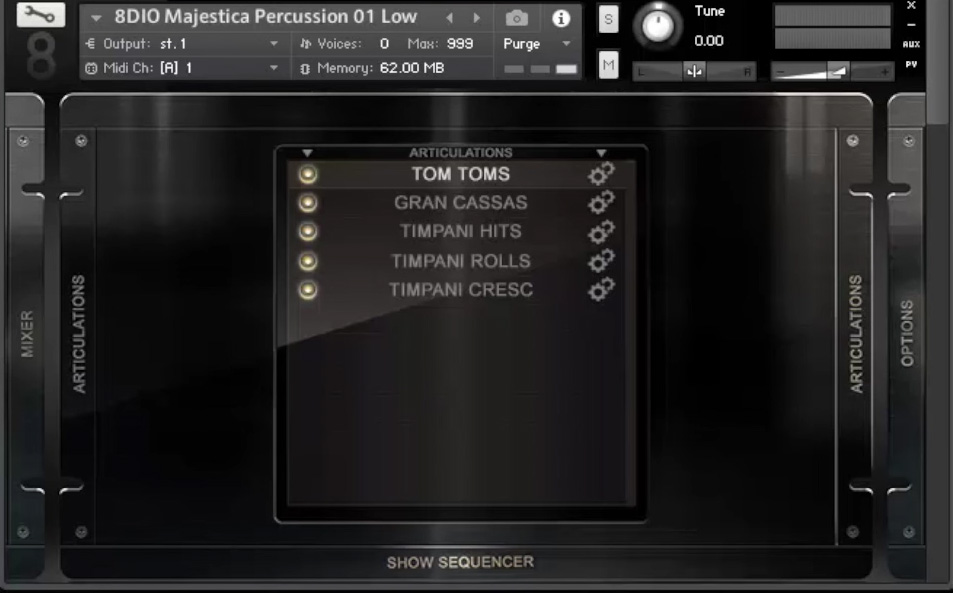Majestica is marketed as the »240 piece epic orchestra« and the largerst symphony orchestra ever sampled. 8dio have recorded a staggering 100 member string section, 60 piece brass section, 60 piece woodwinds section and 20 piece percussion section. I think anyone you ask will agree, that these are some pretty impressive numbers. The real question now is: “Does size matter?” Let’s take a closer look and try to answer this once and for all.
Content and sound
Majestica runs in Kontakt 5.5 and has been recorded in the same hall as the V8P (8dio’s VIP samples), Cage and Lacrimosa choir. It comes with 3 microphone positions (Close, Decca & Far) and will take aprox. 23.5GB of your disk space.
Strings
The 100 piece string section consists of 30 double basses, 30 cellos, 20 violas and 20 violins. I find this setup quite odd, since in a normal orchestral setting you want the most violins, little fewer violas and cellos and the least double basses. A typical setup would be 16 VL1s, 14 Vl2s, 10VAs, 8VCLs, 5DBs. 8dio truly turned the string section on its head… The strings come in 4 patches: Shorts, Longs, Legatos and FX. Each patch then offers several articulations that are triggered via key switches. The sound of the string section is of course quite “majestic”. It is deep, rich and warm and offers multiple dynamic levels. Oddly enough, I found the lower dynamic levels more pleasant then the higher ones.
The quitter dynamics are very soft but are still rich in lovely overtones. Using the sustains or the “arc mp-F-mp” articulation, which makes a nice crescendo from mezzo piano to forte and then a diminuendo back to mezzo piano can produce some lovely chordal background. I do dislike the fact that the arc articulations (which also come in ff-f-ff and mp-mf variations), do not use the elastic audio feature of Kontakt. This means your tempo has to be set to the just the right amount to take advantage of the full crescendo-diminuendo-crescendo….
Have the tempo too high and the samples won’t play the whole way, or have the tempo too low and you will be left with silence at the end of your bar. The short articulations have a very nice attack and can be used with great ease to create movement in Trailer or Epic music genres. Although the legatos come in various lengths (medium, strong, marcato, ect.), they have a very synthy flavour too them. I think the reason for this is the massive string section recorded and also the fact that the various choirs inside the string section are oddly numbers (as I have explained above). I must say, that I really enjoyed the lower range of the legatos, where you get those lovely 30 double basses and 30 cellos playing in unison. The higher ranges where you get the violins, violas and cellos playing in unison sound less pleasing to me.
The overtone build-up is so huge, that you almost hear that you are playing octaves instead of unison notes. This produces a somewhat buzzy string sound that we are usually not used to. I am not saying this is bad, but it is definitely different and I think this is exactly what 8dio was going for; a completely different sound. I have also found, that layering the strings with a nice warm synth produces a lovely result.
Woodwinds
The woodwinds are extremely fun to play with. You have high woodwinds and low woodwinds patches (I wish the same would have been done with the strings…). Both have long, short and FX sub patches with keyswitches. This massive woodwind sections sounds very different as your ordinary woodwind samples libraries. Again, one has to get used to the sound and has to use it wisely. But do that, and you will be able to write some very interesting music. The woodwinds do not come with a legato patch.
Brass
For the brass 8dio recorded 10 cimbassos, 10 bass trombones, 30 french horns and 10 trumpets. As the strings, the brass come all in one and are separated into longs, shorts and FX. My favourite part of the brass are the staccatos and staccatissimos. Imagine the brass staccatos from Pirates of the Caribbean; that is the kind of sound you can easily get with Majestica. My second favourite patches are again the sustains and “arc” paches. They are amazingly great for chordal backing. As in the strings, the lower dynamics are extremely lush. The higher dynamics are immensely powerful! Get ready to produce some epic BRAAMS.
Percussions
I was very pleasantly surprised by the percussion in Majestica. The toms are powerful and will become a staple in my orchestral/epic template. The bass drum, timpani and snares are nothing to joke about as well. The bass drum is one of the nicest and cleanest, bass drums I have heard and the timpani will make a great addition to my template as well. The cymbals, gongs and tam-tams are spot on as well. I really have nothing bad to say about the percussions!
Graphics Interface
Users of other 8dio libraries will already be used to the GUI. In the main window you can select and deselect different articulations. Then you also have a mixer tab where you can play around with the different mic positions. There is also a options tab where you can offset the samples, set their attack and release or even stack different articulations on top of each other (great for sound design). But the best part of the library is the effects window, which is intuitive design to help you easily mangle the sound to your own taste and make it completely your own. Here you can pitch shift, distort or gate the samples. You can also add delay, reverb and other effects. The effects window really makes the library usable in a lot of different scenarios, since with a little ingenuity and luck you will be able to make some very interesting sounds right out of Kontakt itself.
Price performance and conclusion
Majestica is priced at 599$. At first glance I would think the price is quite high, but on the other hand the library is aimed at high-end professionals seeking a new and interesting orchestral sound, so if I look at the price from this perspective, I think the price OK. This is a truly unique product on the market that is still yet to be matched by any other sample library producer. Majestica delivers exactly what it promotes. You get a massive orchestral sample library with a massive sound. But as I have stated in my review, this sound does come with its own downfalls. You have to be very careful not to write with Majestica as you would have written for “normal” orchestral sample libraries, since the sound of Majestica is so rich in overtones, it can quickly sound muddy and “synthy”. So, take great care on how you use it. But use it correctly and you will find yourself in a world of a completely new orchestral sound.
Test track
[ethics]
[reviewSFX]
- The biggest orchestra ever samples
- Unique sound
- One needs to take care on how he uses it
- Can sound synthy
- The “arc” articulations are not tempo elastic




